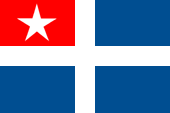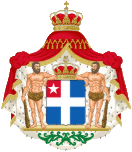Kreta |
|
|
|
| Übersicht – Contents: | |
Kreta |
|
|
|
| Übersicht – Contents: | |
Flagge – Flag: |
|
 |
1898–1913 Flagge des Staates Kreta – flag of Cretan State, Quelle/Source: Die Welt der Flaggen |
Bedeutung/Ursprung der Flagge – Meaning/Origin of the Flag: |
|
| Die Flagge von Kreta enthält zunächst griechische Symbolik in Form des weißen Kreuzes auf blauem Grund, und erinnert an die griechische Kreuzflagge. Im Obereck trägt sie aber ein rotes Feld mit einem weißen Stern, entfernt an die türkische Flagge erinnernt (die Insel stand faktisch bis 1908 unter türkischer Oberhoheit), wobei natürlich der islamische Halbmond weggelassen wurde, und nur der weiße Stern als Symbol der Freiheit und Unabhängigkeit (1898-1913) stehen blieb. | The flag
of Crete contains first of all the Greek symbolism of the white cross on
blue ground and reminds of the Greek cross-flag. But in the upper quadrant it has a red field with a white star, distantly reminding of the Turkish flag (the island stood nominally under Turkish supremacy until 1908), naturally deleting the Islamic crescent, and only the white star remained as symbol of freedom and independence (1898-1913). |
| Quelle/Source: Volker Preuß | |
Wappen – Coat of Arms: |
|
 |
1898–1913, Wappen des Staates Kreta – coat of arms of the Cretan State, Quelle/Source: commons.wikimedia.org |
Bedeutung/Ursprung des Wappens – Meaning/Origin of the Coat of Arms: |
|
| Das Wappen des Staates Kreta war in Aufbau und Gestaltung sehr stark am damaligen Wappen Griechenlands orientiert. Das Wappenschild zeigt die griechische Symbolik in Form des weißen Kreuzes auf blauem Grund. Die Oberecke zeigt jedoch aber ein rotes Feld mit einem weißen Stern, was entfernt an die türkische Flagge erinnernt (die Insel stand faktisch bis 1908 unter türkischer Oberhoheit), wobei natürlich der islamische Halbmond weggelassen wurde, und nur der weiße Stern als Symbol der Freiheit und Unabhängigkeit stehen blieb. |
Structure and design
of the coat of arms of the State of Crete was very much based on the coat of
arms of Greece at that time. The shield shows the Greek symbolism in form
of the white cross on a blue background. The upper corner, however, shows a
red field with a white star, which is remotely reminiscent of the Turkish
flag (the island was de facto under Turkish sovereignty until 1908),
although the Islamic crescent was of course omitted and only the white star
remained as a symbol of freedom and independence. |
| Quelle/Source: Volker Preuß | |
| interaktive Landkarte – interaktive Map: |
|
Zahlen und Fakten – Numbers and Facts: |
|
|
|
|
|
|
|
|
|
|
|
|
|
|
|
Geschichte: |
| 3000–1150 v.Chr. · Minoisches Reich auf Kreta 1200 v.Chr. · Besiedlung durch die Dorier 69/67 v.Chr. · römische Eroberung 64 v.Chr. · römische Provinz 395 · bei der Teilung des Römischen Reiches kommt Kreta an das Oströmische Reich (Byzanz) 823–961 · arabische Besetzung 1212 · Eroberung durch Venedig 1669 · Eroberung durch das Osmanische Reich 1898 · innere Selbstverwaltung 1908 · griechische Oberhoheit 1913 · zu Griechenland 1941–1945 · von deutschen Luftlandetruppen besetzt |
History: |
| 3000–1150 B.C. · Minoan Empire on Crete 1200 B.C. · settlement by the Dorians 69/67 B.C. · Roman conquest 64 B.C. · Roman province 395 · at the partition of the Roman Empire Crete comes to the East Roman Empire (Byzantium) 823–961 · Arabian occupation 1212 · conquest by Venice 1669 · conquest by the Ottoman Empire 1898 · internal self government 1908 · Greek supremacy 1913 · to Greece 1941–1945 · occupied by German paratroops |
| Quelle/Source: Atlas zur Geschichte, Discovery '97, Weltgeschichte |
Ursprung des Landesnamens – Origin of the Country's Name: |
|
| Der Name der Insel lauete schon in der Antike "Krete" und bereits im alten Griechenland war die Herkunft des Names eigentlich unbekannt und es gab schon damals Versuche die Herkunft des Namens meist mythologisch zu erklären. |
The name of the island
was already "Krete" in ancient times and even in ancient Greece the origin
of the name was actually unknown and there were attempts to explain the
origin of the name mostly mythologically. |
| Quelle/Source: Wikipedia (DE) | |